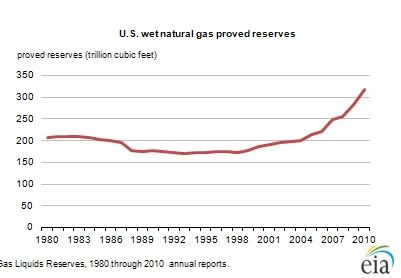- by New Deal democrat
This is the final installment following up on my 2011 prediction that the Oil choke collar would begin to loosen by about this year. I expected that conservation, hybrid vehicles, new oil exploration coming online, technology, and alternate forms of energy, would all gradually increase to the point of overcoming the constricture of expensive crude oil.
One of those alternate forms of energy is already having a big impact: natural gas.
The most recent data up through 2010 published by the E.I.A. in August 2012 shows, proven reserves of natural gas doubled in 15 years, grew by 50% in less than a decade, and were up 25% or more just between 2005-10:

If that trend has continued, then by now reserves have already doubled since 2005. And there is every reason to expect that the trend is continuing. According to Forbes,
"Shell [Oil Company] says that it expects the global demand for LNG to double to $400 million tons by 2020[my emphasis]
... [N]atural gas used for transportation costs 25% less than petroleum.
That huge difference in cost is already transforming the truck and bus fleets in the US. According to the Denver Post:
fleet operators increasingly are realizing the benefits of using natural gas fuel, which runs, on average, about $1.25 per gallon equivalent less than gasoline.So clear is the reeturn on investment that:
"Fleet operators can definitely see the return on investment," said John Gonzales, a senior engineer at the National Renewable Energy Laboratory in Golden.
Trash hauler Republic Services saved $420,000 last year in its 34 trucks that burn natural gas. The company plans to convert more than 3,000 vehicles to natural gas or other alternative fuels by 2015.
According to the American Public Transit Association, nearly one-fifth of all transit buses were run by compressed natural gas (CNG) or liquid natural gas (LNG) in 2011. Currently, transit buses are the largest users of natural gas for vehicles. The fastest growing NGV segment is waste collection and transfer vehicles. Almost 40% of the trash trucks purchased in 2011 were natural gas powered.As a result, Pike's Research's Smart Transportation estimated that:
By year-end [2012], 123,600 natural gas vehicles will be on U.S. roads, compared with 65,500 plug-in vehiclesFurther, the Forbes article reference above, after noting that FedEx, UPS, and Waste Management are already using large numbers of natural gas powered trucks, reported that:
In 2013, four major manufacturers will introduce a 12-liter LNG engine, which is the optimum size for heavy-duty 18 wheeler trucks.And the transformation isn't limited to buses and trucks. Oil and Energy Daily reported that:
Three of the biggest U.S. rail carriers – Burlington Northern Santa Fe LLC, Union Pacific Corp.(UNP), and Norfolk Southern Corp. (NSC) – are all turning to natural gas as an alternative power source for freight trains.In summary, while natural gas has not been adopted for passenger vehicle use, America's commercial transportation fleet is becoming natural-gas-powered with astonishing rapidity.